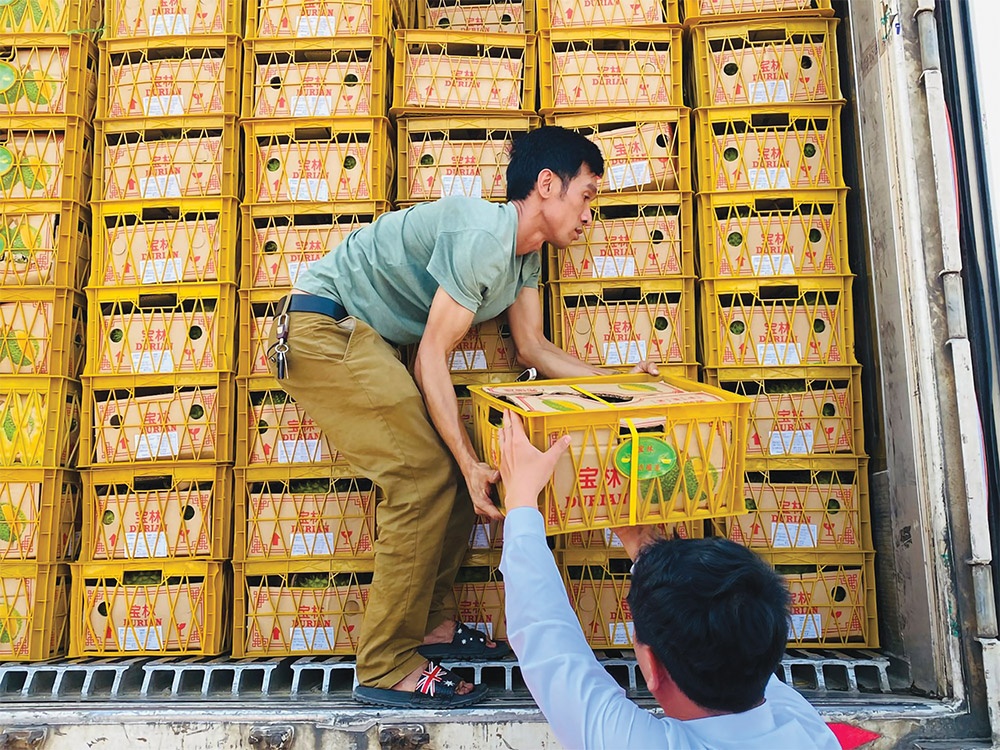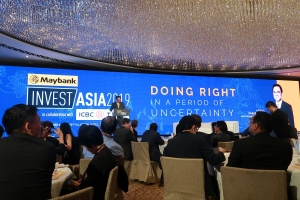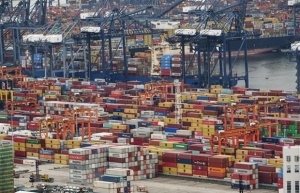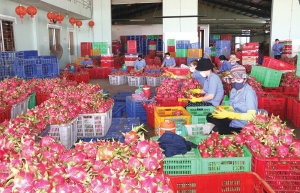ASEAN-China upgrade to aid trade
Official figures from the General Statistics Office (GSO) have reported that in the first seven months of this year, total trade turnover between Vietnam and China hit an estimated $112.6 billion, with exports from Vietnam reaching $33.4 billion – up 7.6 per cent on-year, and exports from China coming at $79.2 billion – up nearly $35 per cent as compared to the same period last year.
 |
| The trade ties between Vietnam and China are expected to be spurred on by the new ACFTA upgrade and the RCEP |
Meanwhile, fresh figures from the Ministry of Planning and Investment showed that cumulatively as of July 20, Chinese businesses had nearly 4,760 valid projects registered at $28.55 billion in Vietnam – making China the sixth-largest foreign investor.
In the January-July 20 period, total newly registered and newly added capital and stake acquisition and capital contributions from Chinese investors in Vietnam stood at $1.65 billion.
According to the GSO, bilateral trade and Chinese investment into Vietnam are expected to continue rising at least from next year following the expected adoption of a new version of the ASEAN-China Free Trade Area (ACFTA), in addition to positive impacts from the Regional Comprehensive Economic Partnership (RCEP).
“We reaffirmed ASEAN’s commitment to achieve meaningful progress of the negotiation in line with ASEAN’s interest in order to reach substantial conclusion of the ACFTA 3.0 upgrade within this year,” stated the joint communiqué of the 57th ASEAN Foreign Ministers’ Meeting organised in late July in Laos.
Relevant Vietnamese ministries and agencies are now working with ASEAN member states and China about how version 3.0 will work and help enterprises after being adopted as scheduled at the end of this year.
The ACFTA, which is the cornerstone of ASEAN-China relations, has removed tariffs for about 95 per cent of tariff lines of exports to China that originate from Vietnam. China has also done the same with ASEAN member states.
The deal’s new version is set to create favourable market access and ensures a more predictable operating environment for services suppliers. It will also provide investors and investments with protection by establishing a more transparent, facilitative, and secure environment for investors.
Under the upgrade negotiations, ASEAN member states and China will also address trends such as supply chain connectivity, digitalisation, and sustainability.
The deal’s original version was established in 2010, with more than 90 per cent of the tax items of both sides enjoying zero tariff treatment, and was first upgraded in 2019.
Deepened cooperation
Under a joint statement released late last year during a two-day third state visit to Vietnam by General Secretary of the Communist Party of China and Chinese President Xi Jinping, Vietnam and China agreed to boost the ACFTA upgrade which will help further sharpen the comprehensive strategic partnership between ASEAN and China.
The two countries also “agree to apply practical measures to expand the scale of bilateral trade in a balanced and sustainable direction, while promoting the role of the RCEP and the AFCTA,” and they will also expand the export of strong products from one country to another.
On July 25, Prime Minister Pham Minh Chinh received Wang Huning, Chairman of the Chinese People’s Political Consultative Conference National Committee. He stated that it is necessary to deepen practical cooperation in such areas as economy-trade, investment, and transport infrastructure connectivity between the two economies.
Earlier at the 20th China-ASEAN Expo and China-ASEAN Business and Investment Summit held last September in Guangxi province, PM Chinh said that ASEAN and China needed to strongly promote bilateral trade in a balanced and sustainable manner, striving to turn the bloc into China’s first trading partner with trade value exceeding $1 trillion.
He also suggested coordinating to build linkage chains from raw material areas to production centres and product consumption systems, and continuing to open the market, combating protectionism, cooperating to improve adaptation ability to new standards and green products, while promoting science-technology cooperation and innovation.
Vietnam wants to continue working with China and other ASEAN member states about quickly completing the negotiations of the ACFTA upgrade, PM Chinh stated.
Last month, at a meeting initiated by the Network of ASEAN-China Think-Tanks Working Group on ASEAN-China cooperation on industrial and supply chains, Professor Gao Fei, vice president of China Foreign Affairs University, said that the trade and investment ties between ASEAN and China are on the rise, with Vietnam demonstrating its big advocacy for cooperation mechanisms between ASEAN and China.
“A number of initiatives including the RCEP and the ACFTA upgrade are testaments to our commitment to deepening economic integration and promoting a more interconnected and interdependent regional economy,” Fei said.
Great impacts
Vietnam is on high hope that its trade and investment cooperation with China will be promoted via not only the ACFTA, but also the RCEP of which China and ASEAN are also members.
According to the ASEAN Secretariat, China has retained its position as ASEAN’s largest trading partner since 2009, and ASEAN has become China’s largest trading partner for three consecutive years since 2020. In 2023, trade volume between both reached a record of $702 billion, making China the largest trading partner of ASEAN for 15 consecutive years. Investment flows from China to ASEAN amounted to $15.5 billion in 2022, and equivalent to 6.9 per cent of total foreign direct investment flows to ASEAN.
These positive results have been made significantly thanks to the RCEP. The biggest benefit from the deal is preferential tax rates, with zero tariff being applied on more than 90 per cent of goods traded by its members.
The two-way trade between China and Vietnam has witnessed high growth thanks to the implementation of the RCEP and the ACFTA, according to the Ministry of Industry and Trade.
Last year, total two-way trade turnover between the two countries sat at $173.3 billion, with Vietnam’s exports worth $61.7 billion, up 6.4 per cent on-year, and Vietnam’s imports were valued at $111.6 billion, down 6.9 per cent on-year. China was responsible for one-quarter of Vietnam’s total trade in 2023, with 17.3 per cent of export turnover and 34 per cent of import value.
Two months ago, PM Chinh met with Chinese Premier Li Qiang in Dalian city of Liaoning province, saying that the two countries should leverage the advantages of the RCEP and other cooperation mechanisms including the ACFTA to intensify trade and investment ties. They should also soon ink a protocol and complete market opening procedures for Vietnamese frozen durian and fresh coconut, as well as other types of agricultural products.
PM Chinh also asked the Chinese side to create new advantages for the early establishment of the Vietnam Trade Promotion Office in Chengdu, Haikou, and Nanjing. In addition, Vietnam and China would also work on new measures to increase customs clearance efficiency, improve border gates’ infrastructure towards developing smart border gates, while also needing to work on removing bottlenecks of some cooperation projects.
Premier Qiang stated that China will further open its market for Vietnamese goods, especially agricultural and aquatic products and high-quality fruits, while also boosting coordination in customs clearance and removing hurdles about policy so that both nations’ trade and investment cooperation can further develop.
China and Vietnam will also increase strategic connectivity and cooperation, especially in infrastructure, transport, economic-trade and investment - particularly in manufacturing and processing, agriculture, supply chain, and financial and monetary cooperation.
In May, PM Chinh met with 19 Chinese business representatives at a meeting in Hanoi that Vietnam prioritises projects involving in innovation, digital transformation, renewable energy, smart cities, manufacturing, and transport infrastructure.
“New projects should centre on developing a sustainable business model that includes Vietnamese businesses in the value and supply chains of regional and global corporations,” the Vietnamese leader said.
 | Opportunities for Vietnam from disrupted China-ASEAN ties The global trade war is expected to quicken the production shift to Vietnam as part of its spillover effect on China and the ASEAN, said Maybank Group in today’s conference in Singapore. |
 | China-ASEAN Trade Index released for first time The China-ASEAN Trade Index was released for the first time during the ongoing 18th China-ASEAN Expo and China-ASEAN Business and Investment Summit held in Nanning - the capital city of China's Guangxi Zhuang Autonomous Region. |
 | China-ASEAN trade to get fresh booster An upgrade of the ASEAN-China free trade deal and positive impacts from the Regional Comprehensive Economic Partnership are set to benefit Vietnam-China trade ties. |
 | The positive impact of ASEAN-China cooperation Prime Minister Pham Minh Chinh and a Vietnamese delegation have concluded their trip to to attend the 20th China-ASEAN Expo and the 20th China-ASEAN Business and Investment Summit in China’s Nanning province. |
What the stars mean:
★ Poor ★ ★ Promising ★★★ Good ★★★★ Very good ★★★★★ Exceptional
Related Contents
Latest News
More News
- 72 nations sign landmark Hanoi cybercrime convention (October 26, 2025 | 18:00)
- UN Secretary-General commends Vietnam’s global leadership (October 26, 2025 | 09:00)
- APEC finance ministers convene to tackle regional challenges (October 22, 2025 | 17:31)
- Rewiring global trade: ASEAN’s rise as supply chain hub (October 17, 2025 | 11:40)
- Vietnam attends first World Nuclear Week Forum in Russia (September 26, 2025 | 10:50)
- Vietnam attends 69th session of IAEA General Conference (September 16, 2025 | 10:00)
- ADB, WB pledge over 12 billion USD for ASEAN power grid, renewable energy projects (August 15, 2025 | 14:18)
- Lowy Institute proposes AI-based tobacco control solutions for ASEAN (August 15, 2025 | 14:14)
- Cloud computing policy to position Malaysia as regional hub by 2030 (August 15, 2025 | 14:11)
- Thailand, Cambodia suffer numerous cyber attacks (August 05, 2025 | 16:19)

 Tag:
Tag:




















 Mobile Version
Mobile Version